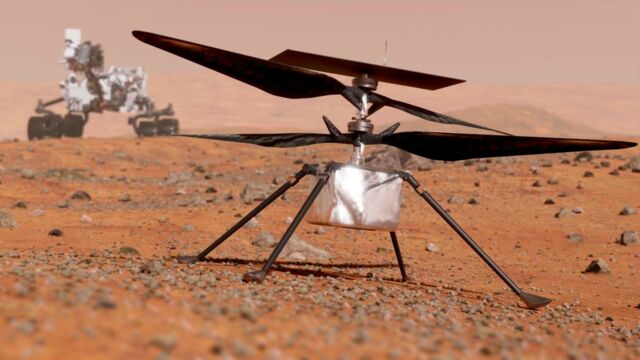NASA is ready to make a helicopter drone fly on Mars

NASA's Ingenuity Mars helicopter has separated from the Perseverance rover. It is almost ready to usher in a new form of space exploration.
NASA's Ingenuity Mars helicopter has survived its first night alone on the Red Planet. After slowly deploying from its hiding place in the belly of the Perseverance rover, the 1.8-kilogram robot called Ingenuity touched down on the ground on Saturday. By resisting freezing temperatures, Ingenuity overcame one of the biggest hurdles in NASA's quest to fly the first drone to another planet.
Discover our latest podcast
Baby steps in the sky
Ingenuity is ready to make its first Martian flight on Sunday. If all goes well, the space drone will have a window of around 30 days to attempt up to five increasingly difficult flights, each time venturing higher and further. NASA's Perseverance rover, which transported Ingenuity to Mars, will station nearby and record some footage. These images will help NASA gather crucial data on this technological demonstration, which could pave the way for a new method of exploring other planets. Now that it is deployed, Ingenuity is ready for these flights
More under this adMore under this adAfter lowering the helicopter to the ground, the rover backed up, exposing Ingenuity's solar panels so they could absorb sunlight. It also exposed the rotary-wing drone to freezing Martian nights. In the Jezero crater, the ancient lake basin where Perseverance landed, night-time temperatures can drop to -54C°.
MiMi Aung, NASA's helicopter project manager, said in a press release:
This is the first time Ingenuity has found itself alone on the surface of Mars, but now we have confirmation that we have the right insulation, the right heaters and enough energy in its battery to survive the cold night, which is a big win for the team. We can't wait to continue to prepare Ingenuity for its first flight test.More under this adMore under this ad
Ingenuity's flight to another world could be the first in a long series
NASA spent $85 million (approximately £61 million) to develop Ingenuity. The rotary-wing drone has already proven itself tough enough to survive the nearly 483 million kilometre journey to Mars and withstand the planet's extreme temperatures. But it must now also fly. The atmosphere on Mars is incredibly thin; its density is only 1% of that of the Earth. To catch enough air, the helicopter's four carbon fibre blades must spin in opposite directions at about 2,400 rpm, about eight times faster than a passenger helicopter on Earth.
Ingenuity's first flight will simply check if the helicopter can take off a few feet from the ground, hover for about 30 seconds, and then land again. From there on, each test will become more difficult, culminating in a final flight that could carry the helicopter more than 300 meters above Martian soil.
More under this adMore under this adAn expensive proof-of-concept
Ingenuity will not conduct any other scientific activity on Mars—it is a technology demonstrator—but future space helicopters could open new scientific frontiers on other planets. Håvard Grip, NASA's chief pilot for Ingenuity, said at a press briefing in March:
We use drones and helicopters here on Earth for all kinds of things for which they're more suited than ground vehicles.More under this adMore under this ad
On other planets, it is believed that similar aerial explorers could accomplish tasks that rovers cannot. 'It could be for reconnaissance—taking pictures to spot areas, potential scientific targets for future rovers, or even future astronauts on Mars,' Håvard Grip said.
It could also transport its own scientific instruments to areas where it is impossible to access with a land vehicle.More under this adMore under this ad
After Ingenuity's test flights are done, Perseverance is expected to head to the cliffs of an ancient river delta for its own ground-breaking science mission: to search for micro-fossils of ancient alien microbes on Mars.